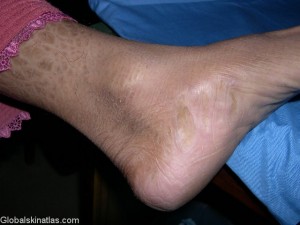What is Ichthyosis Vulgaris?
Ichthyosis vulgaris is one of the most common of all inherited skin disorders. It causes dry, dead skin cells to accumulate in patches on the surface of your skin and is also known as “fish scale disease” due to the dead skin accumulating in a similar pattern to a fish’s scales. In ichthyosis vulgaris, the skin cells are produced at a normal rate, but they do not separate normally at the surface of the stratum corneum (the outermost layer of skin) and are not shed as quickly as they should be. The result is a build-up of scales.
Genetics also play a role in the transmission of the skin disorder. Ichthyosis follows an autosomal dominant pattern which means that only one parents needs to possess the mutated gene in order to pass it on to the child.
What are the symptoms?
Symptoms of ichthyosis vulgaris include:
- a flaky scalp
- itchy skin
- polygon-shaped scales on the skin
- scales that are brown, grey or white
- severely dry skin
- thickened skin
When is it most likely to occur?
Symptoms of ichthyosis vulgaris are typically worse in winter, when the air is colder and dryer, they usually worsen or are more pronounced in cold, dry environments and tend to improve or even resolve in warm, humid environments.
How do you get Ichthyosis Vulgaris?
The majority of cases are mild and confined to specific areas of the body. However, some cases are severe and can cover large areas of the body, including the abdomen, back, arms, and legs. Usually only a portion of the body may be involved (scaling is most common and most severe over the lower legs), the scale is usually fine and white. Scaling on the torso is usually less severe and the face is usually unaffected. When the face is affected, the scaling is usually limited to the forehead and cheeks.
Who can get Ichthyosis Vulgaris?
Ichthyosis vulgaris can be inherited if one parent carries the mutated gene and may be present at birth or can appear in the first few years of a child’s life, but it typically disappears during early childhood. Some people may never have symptoms again, but for others, it can return during adulthood.
How can you treat/manage Ichthyosis Vulgaris?
Researchers have yet to find a cure for ichthyosis vulgaris, so the key to controlling your symptoms is receiving ongoing treatment.
The first line of defence against scaly, dry skin is using thick moisturizers on the affected area on a regular basis. This may include applying thick creams and ointments several times a day. The experts suggest using moisturizers with urea or propylene glycol, using moisturizing, fragrance- and dye-free soaps can also help. Regular visits to your podiatrist where they can help provide you with the best treatments will help manage Ichthyosis Vulgaris.


Comments are closed.